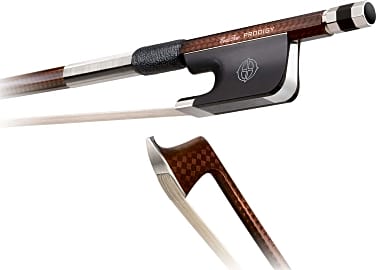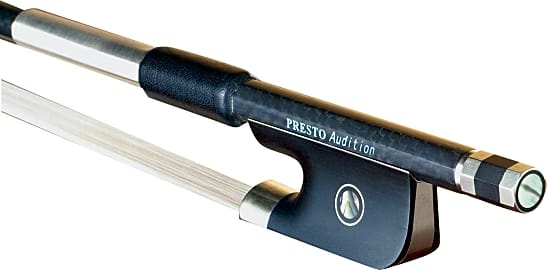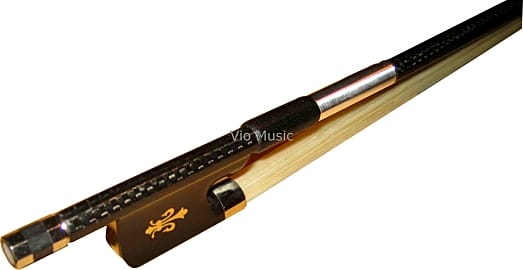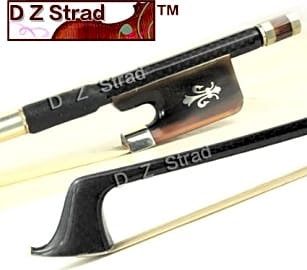The 7 Best Carbon Fiber Cello Bows

This wiki has been updated 33 times since it was first published in December of 2016. When playing a stringed instrument, the durability and forgiving nature of its components can be just as important as technique. Both budding cellists and experienced professionals can benefit from one of these sturdy carbon fiber bows, which are lightweight, super strong, and won't react harshly to changes in temperature or humidity, so that they always deliver a consistent sound. When users buy our independently chosen editorial choices, we may earn commissions to help fund the Wiki.
Editor's Notes
October 07, 2019:
When a musician is in the market for a carbon fiber bow they tend to fall into two categories. One group wants a bow that is closest in sound to their high-end wooden bow, perhaps for outdoor performances or travel, or they are a beginning to intermediate player who would like to upgrade from whatever cheap bow they currently have and so probably don't want to invest a lot.
The Coda Bow Diamond GX and the Jon Paul Avanti are both models that strive to emulate the most sought after pernambuco bows in sound and performance, with the added advantage of increase durability and resistance warping from dampness and humidity.
Choices like the Fiddlerman 4/4 and the Vio Music Braided, while not suitable for professionals, will encourage students to continue developing their skills with the higher quality tone and ease of handling that come with these models.
Mid-range choices like the DZ Strad 301 or the Presto Audition were included for advanced students or professionals who would like a good quality back-up bow without making a huge investment.
We decided to remove the Vingo Bow 4/4 due to durability concerns with the tip of this bow.
The Importance Of A Cello Bow
Until relatively recently, only specific, increasingly expensive woods could achieve this ideal marriage of durability and responsiveness at an optimal weight.
When first learning to play the cello or any stringed instrument, students and parents alike may think of the bow as just another accessory that comes along in the case, much like the free cake of rosin that comes included with many beginner rentals. Even when the time comes for the budding musician to graduate to something better than a basic rental, one might initially focus on the quality of the cello itself in the quest of producing a better sound. But as any accomplished string musician will tell you, while the sound emanates from the cello, the bow is equally responsible for the caliber of that tone. Yes, the proper placement of fingers on the left hand ensures the correct pitch of the note you are playing, but nearly everything else about that note is determined by what is done when your right hand strikes the bow across those strings.
In pursuit of the perfect sound, the bow is responsible for everything from volume to that indelible quality of the tone that exudes warmth, brightness, and other characteristics that can only be mastered with hundreds, if not thousands, of hours of practice. As the student begins to develop their technique, they may spend hours per day with this implement in their hand, so proper construction is crucial. The two most important elements are the hair and the stick. Genuine horsehair is essential; and for the best grip on the strings, all high-level musicians require the natural coarseness of Mongolian horsehair. The material used for the stick ensures the bow is of the ideal weight and balance, with proper responsiveness for lightning-fast staccatos as well as soaring adagios, all while maintaining a sufficient density to prevent snapping at an inopportune moment.
For a full-sized cello, the best bows weigh in at almost exactly 80 grams. Until relatively recently, only specific, increasingly expensive woods could achieve this ideal marriage of durability and responsiveness at an optimal weight.
A Brief History Of The Cello Bow
While the cello was invented in 16th-century Italy, shortly after the appearance of the violin and viola, the concept of drawing a bow across strings to create music appears to have originated with the nomadic horse riding cultures of Central Asia sometime in the 10th century. To this day, the coarser hair of horses from the harsh, cold climates of Mongolia are the used by bowmakers. These horse-mounted warriors were typically archers, and so may have first used their military bows to hold the horsehair at high tension when inventing the bow. In addition, archers already used rosin to maintain their military bows, and a thick rosin coating is essential to creating sound with a horsehair bow. The usage of a bow to make music spread quickly, so that by the year 1000 C.E., it could be found throughout Asia, Europe, and Northern Africa.
The French dance bow, commonly used until the early 1700s, was played with small, quick strokes to create rhythmic dance music.
Early cello bows were much shorter than the modern western bow. The French dance bow, commonly used until the early 1700s, was played with small, quick strokes to create rhythmic dance music. By 1725, a slightly longer Italian sonata bow produced a lighter and clearer sound, and also introduced the concept of the screw for adjusting the tension of the hair.
The father of the modern bow, François Tourte, passionately hand-crafted bows in his small workshop from the late 18th century until his vision began to fail in 1832, and he is generally regarded as the greatest bowmaker of all time. His bows are still prized by professional musicians and often sell for hundreds of thousands of dollars at auction. Preference for his bows instituted a definitive length, weight, and even the ideal number of hairs (200), as well as establishing Pernambuco wood as the gold standard for the stick. Nearly all wooden bows are made with Brazilwood, from the Pau Brasil tree, but the highest quality and most sought-after bows are crafted soley from the denser heartwood of that same tree, dubbed Pernambuco. Tourte determined this material imbued the bow with the optimal flexibility, resistance, and weight.
Why Use A Carbon Fiber Bow
Despite Pernambuco being hands down the material of choice for any professional stringed instrument player's bow, there are a variety of reasons as to why even serious musicians are beginning to choose to have at least one carbon fiber bow in their arsenal. One of the primary reasons for the rise in usage of carbon fiber bows is sustainability issues with Brazilwood. Excessive exploitation of this prized tree has caused it to be listed on the official list of endangered flora of Brazil. Efforts are underway to help restore the species, but the tree is difficult to grow outside its natural range.
Musicians who live in excessively warm climates, or who frequently perform outdoors will often choose carbon fiber.
Although a top-notch carbon fiber composite bow isn't cheap, the shortages of Pernambuco have driven the price for these bows so high that cost is another reason to consider carbon fiber. While discerning ears feel the sound of a carbon fiber bow will never match that of a wood counterpart, advancements in the development of the artificial sticks have recently brought them closer in warmth and tone. Manufacturers are so serious about the improvement of the technology that at least one prominent company was founded by an aerospace engineer, a composite scientist, and a bowmaker.
A carbon fiber bow also has several functional advantages over a wood bow. The material is not subject to the humidity and weather conditions that over time can warp even the most expertly crafted wooden bow. Musicians who live in excessively warm climates, or who frequently perform outdoors will often choose carbon fiber. Composite bows are also even more durable than any kind of Brazilwood, and are less likely to snap, which can be just about the worst thing to happen to a performer while on stage.












